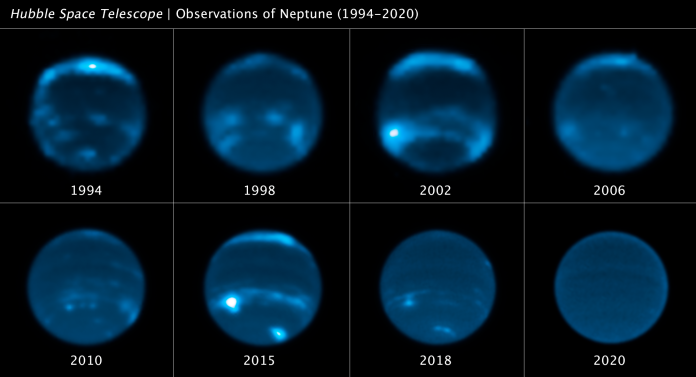Scientists may have answered after a thorough observation why the clouds on Neptune have started vanishing except the ones on its South Pole, with the help of pictures taken from 1994 to 2019.
Researchers observed images of Neptune taken from 1994 to 2022 and identified a link between cloud disappearance and the solar cycle.
According to the research published in the journal Icarus, this link is “surprising” given that the planet is the farthest major planet in the Solar System, receiving only 1/900th of the sunlight Earth gets.
A co-author Imke de Pater from UC Berkeley said: “I was surprised by how quickly clouds disappeared on Neptune. We essentially saw cloud activity drop within a few months.”
Researchers found that when the sun emits more intense ultraviolet (UV) light more clouds tend to appear on Neptune about two years later.
In their study, they also identified another link between the number of clouds on Neptune and the ice giant’s brightness from the sunlight reflecting off it.
“Our findings support the theory that the sun’s UV rays, when strong enough, maybe triggering a photochemical reaction that produces Neptune’s clouds,” Dr de Pater said.
He added: “These remarkable data give us the strongest evidence yet that Neptune’s cloud cover correlates with the sun’s cycle.”
The association was underlined between the solar cycle and Neptune’s cloudy weather pattern after assessing 2.5 cycles of cloud activity that were recorded over nearly three decades of observations of the icy blue planet.
Astronomers concluded that the reflectivity of Neptune increased in 2002, then dimmed in 2007, became bright again in 2015, then darkened in 2020 to the lowest level ever observed – when most of the clouds went away.
They also maintained that more work is necessary for a better understanding of the correlation and the role of the other factors.
Scientists said while an increase in UV sunlight could produce more clouds and haze, it could also darken them, reducing Neptune’s overall brightness.
Continued observations of the planet are also needed to see how long the current near-absence of clouds will last, the researchers underlined.
“We have seen more clouds in the most recent images, in particular at northern latitudes and at high altitudes, as expected from the observed increase in the solar UV flux over the past ~2 years,” Dr de Pater said.


